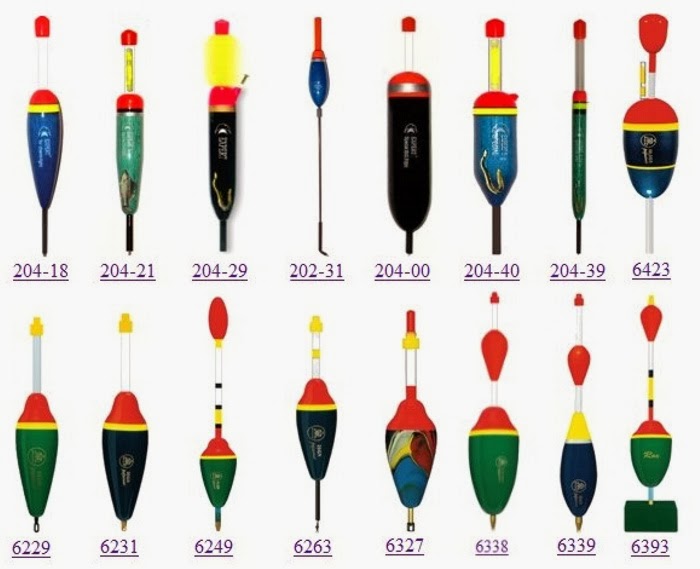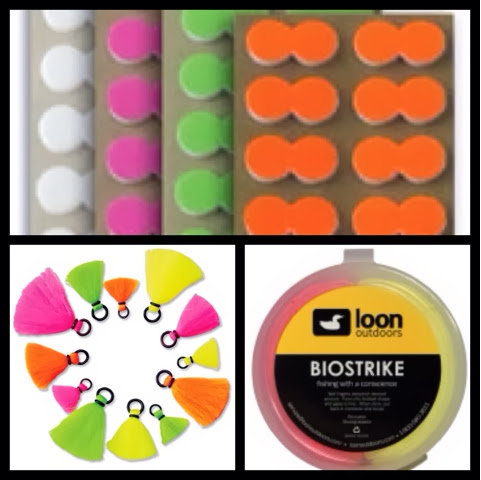 |
| Just add batteries for night time brown poaching |
What Indicators to Avoid... like for real, don't use these
Personally I feel that putty indicators, sticker indicators, and big yarn indicators with rubber o-rings all suck.
 |
| Not my favs. Clockwise from the top: Stickers, putty, o-ring yarn. |
Putty leaves residue on your leader, doesn't float well, and doesn't work as well in the cold when you are most apt to use an indicator/bobber/nibble detector/eat-meter.
Sticker Indicators are wind resistant and cause drag when casting, leave sticky residue on your leader, and don't float well. Burn 'em.
Yarn Indicators with rubber o-rings are also very wind resistant and hard to keep floating. Too much silicone applied to them and they sink from the weight of the silicone and rubber o-ring. Too little silicone and they sink from water absorption.
My 3 favorite Strike Indicators ... (money makers)
My go to strike indicators are Lightning Strike football indicators, Thing-a-ma-bobbers, and Lefty Kreh's indicator yarn. None of these are perfect, hence the reason I have three favorites. I use these in different scenarios.
 |
| I likes the white footballs for their bubble camo qualities |
 |
| the industry standard fly bobber |
and became the industry standard for fly fishing bobbers by calling a spade a spade. As it's name suggests, it's a bobber people. These things float high and they are easy to see and easy to use. Nuff said. Although these bright balls aren't aerodynamic, their heft allows them to punch through the air better than their light but clumsy yarn counterparts. If you get the bright colored ones, nothing is easier to see on the water. The kryptonite for the Thingamabobber is that it's loud to hit the water, can be easy to spot by educated trout who have previously felt the sting of a hook after watching the popular Thingamabobber float by, and they leave a sharp kink in your leader when you take them off or move them. I like to use these indicators when teaching people to nymph, fishing stocked trout with mush for brains, or when fishing deep water that needs and indicator to float high and keep your flies from snagging bottom or dropping deeper than where the fish are feeding.
 |
| best yarn indi if you go yarn |
Other strike indicators are out there for sure, and a lot of it boils down to personal preference. Czech nymphers use a piece of fluorescent amnesia type material in their leaders as an indicator. I haven't tried this style of strike indication yet, but I can see the merit in it. Fish Pimp makes a football type indicator as well that looks sexier than the lightning strike football packaging and product, but I haven't tried those either.
Bobber Basics
The simple rule of thumb is that you estimate the water depth, multiply by two, then place your indicator that distance from your lead fly. If the water is 3 feet deep, place your indicator 6 feet up your leader from your fly. This is assuming you are trying to get your fly to the bottom of the river. Another rule of thumb is if you aren't occasionally get hung up on the bottom, you probably aren't deep enough. Add weight or adjust your indicator.
The biggest variable in the twice-the-depth-of-the-water formula is current speed. If the water is ripping through a run, you need to place your indicator further from your lead fly to allow it time to sink deeper (If I am fishing two of three flies, I consider the fly that is closest to my fly line the lead fly). Counter to fast water, in slow water, you may need to slide your indicator down closer to your rig to prevent it from sinking like a rock and hanging up before your drift even makes it to the feeding lane. Beware! In slow water the fish are more wary and have more time to examine you flies, and an indicator closer to your set up may be enough for educated or spooky trout to move into the lock-jaw state, and kill your chance of an eat.
There you have it. Josh Jones' bobber bonanza. Remember these are only my opinions, and if you don't care for the opinion of a dead sexy, expert fly fisherman with chiseled abs and credentials to make anglers around the world blush...then your in luck, 'cause I'm just the local idiot. Happy bobber fishing rednecks.
